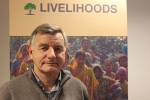 The Livelihoods Fund was officially created a year ago. What happened since? What are the main achievements? The main challenges? We asked Bernard Giraud, co-founder of the Fund and President of Livelihoods Venture, the Fund’s investments adviser.
The Livelihoods Fund was officially created a year ago. What happened since? What are the main achievements? The main challenges? We asked Bernard Giraud, co-founder of the Fund and President of Livelihoods Venture, the Fund’s investments adviser.
The global market leader in professional computer softwares SAP just made public its decision to invest in Livelihoods. How do you interpret this decision?
BG – SAP’s decision indicates that Livelihoods dynamic is still functioning. The Fund is growing and attracting new partners. Since its creation a year ago, 8 large companies joined the fund. The companies are interested by innovative economic models that create value for both parties : on the one hand the investing company gets high social and environmental quality carbon credits, and on the other hand rural communities benefit from the means to improve their food security on the long term. SAP’s investment in Livelihoods is also recognition of the robustness of the process because before getting involved, the companies that invest in Livelihoods proceed with advanced due-diligences on the methods, the organisation and the impact of the Funds.
What does Livelihoods bring to companies?
BG – Livelihoods is a carbon fund but not just that. Our first duty is to help our companies get carbon credits at the best quality level as anticipated in the business plan. For the companies that are members of Livelihoods, the main priority is to reduce the carbon footprint on their activities. In addition, the Livelihoods carbon credits help them partially offset what they couldn’t reduce. But beyond the carbon offsetting, Livelihoods is also an experimentation platform where companies are able to work on significant solutions with NGOs, public institutions or the private sector. For instance, Schneider Electric on energy access, Danone on nutrition, Credit Agricole on financing, etc.
How far along are the projects financed by Livelihoods?
BG – Livelihoods invests in large scale projects and on the long-term. The Fund has invested in 6 projects so far, 3 in Africa, 3 in Asia. The oldest project is the restoration of mangrove swamps in Senegal handled by the NGO Océanium that enabled 420 villages to plant over 10,000 ha of mangrove swamp, which equals Paris surface. More than 100 million seeds of mangrove have been planted, which is in fact the biggest mangrove swamp restoration project in the world. The projects in Asia are developing well : in the Araku valley in India, 2 million fruit trees have already been planted by the adivasi communities, in the Sundarbans in Bengal, reforested mangrove area exceeds 3,000 ha and in Indonesia, in Sumatra island, the first year of plantation is a success. These ecosystems will generate significant resources for rural communities who are involved in these projects: for example, in Senegal, in few years, restored mangroves will produce 18,000 tons of fish annually and in India, 10,000 tons of mangoes per year in the Araku valley.
How does Livelihoods work with NGO’s?
BG – Livelihoods would not be able to do anything without NGOs and social entrepreneurs that conceive and put into action the projects on the field. This long-term partnership between NGOs strongly committed to the rural communities and the Fund, is at the heart of the Livelihoods model. The Livelihoods Network has been created precisely to reinforce this cooperation. A very promising signal : the success of the Livelihoods Camp held last October in Araku (India) that brought together 140 participants from 65 organisations coming from 21 countries to work together on concrete projects.
The international negotiations on climate linger, and the carbon markets are marginalized. What are the consequences on Livelihoods?
BG – The situation is paradoxical. On the one hand, in a rough economic context and without true global governance, States are struggling to go beyond the defense of national interests and build a genuinely committing framework. On the other hand, the public opinion is more and more aware that the current models are not sustainable nor can they be applied generally, and that the unsolved problems will haunt us. Civil society organizations, companies and local governments almost everywhere in the world are not giving up and are pursuing their efforts to come up with solutions. The respect of the carbon credits rules that is selfwilled is great proof. Livelihoods is part of this movement. The fund was created for 20 years and we know that we work on issues that will get more and more important.
What are the priorities of Livelihoods for 2013?
BG -With our partners, we hope to develop and strengthen the projects we are involved in. We also hope to launch two new projects in 2013, to increase the Fund’s resources and the impact of the Livelihoods Network. One thing is sure, we are not going to be bored !

